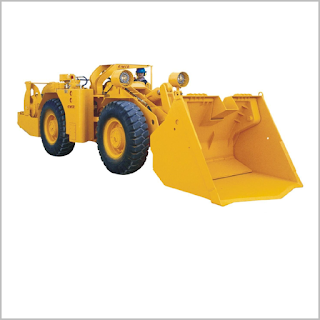load haul dumper
LHD loaders are similar to conventional Front end loader but developed for the toughest of Underground mining (hard rock)applications, with overall production economy, safety and reliability in mind.They are extremely rugged, highly maneuverable and exceptionally productive. More than 75% of world's underground metal mines use LHD for handling the muck of their excavations
Constructional details
LHD have powerful prime movers, advanced drive train technology, heavy planetary axles, four-wheel drive, articulated steering and ergonomic controls. Their narrower, longer and lower profile make them most suitable for underground application where height and width is limitations. As the length is not a limitation in underground tunnel and decline LHD are designed with sufficient length. The length improves axial weight distribution and bucket capacity can be enhanced. The two-part construction with central articulation helps in tracking and maneuverability. In Mining there is limitation for shifting heavy equipment. Sometimes, an LHD has to be shifted through a shaft while dismantled.
Capacity
Their tramming capacities varies from 1 to 17-25 metric tons. Their bucket size varies from 0.8 meter cube to 10 meter cube. Bucket height range from 1.8 meter to 2.5 meter.
Drives
LHD are available in both diesel and electric versions. Diesel version is easily transportable from one location to another and have diesel engines as power drive of 75 HP to 150 HP or more. Engines are either water or air cooled.
LHD with electric motors as drives have general capacity of 75HP to 150 HP. These are operative at medium voltage of 380 Volt to 550 Volts. Flexible trailing cable are provided with reeling/unreeling facility to feed power.
These drives operate hydraulic pumps and hydraulic motors for further operation of various movement of bucket and vehicle traction/steering.The speed of the vehicle is controlled mechanically. The transmission is controlled by a hydrostatic drive. In hydrostatic transmission, the motor drives a variable displacement pump hydraulically connected to a hydro-motor driving the axle via a gearbox. The speed is controlled by changing the displacement volume of the axial pump. The power train consists of a closed loop hydraulic transmission, parking brakes, two-stage gear box and, drive lines









0 comments: